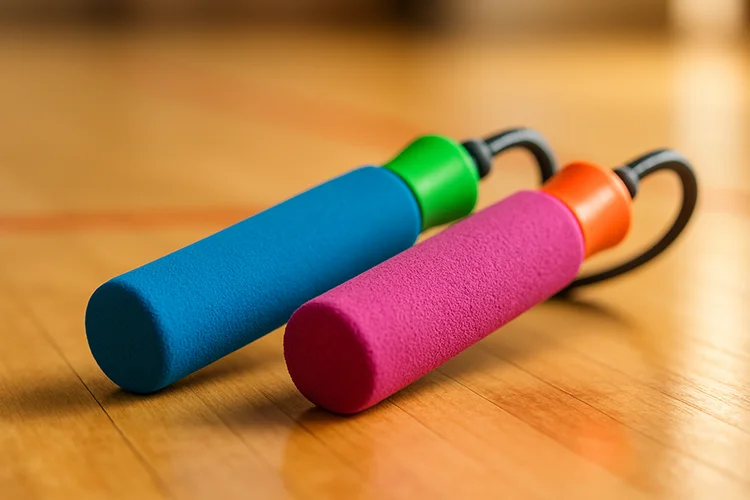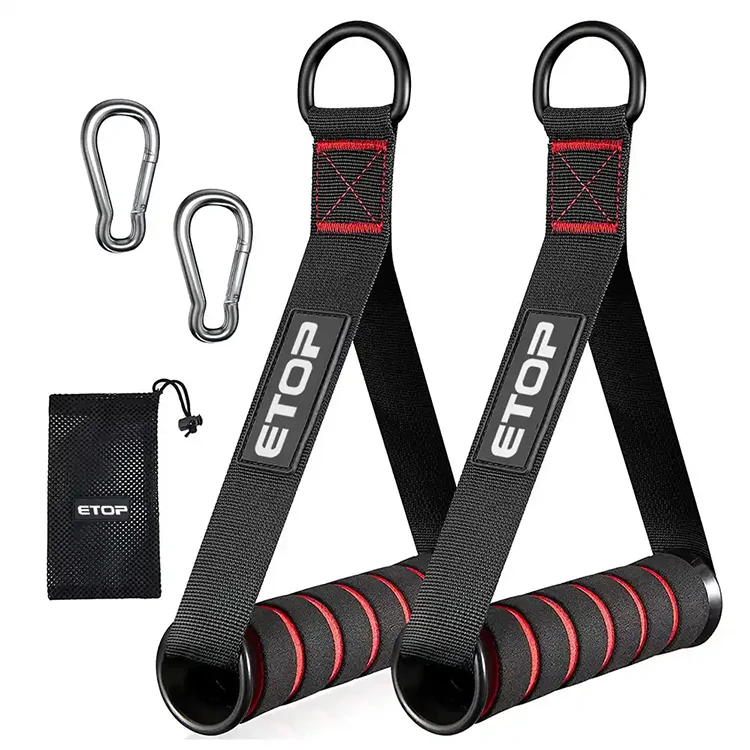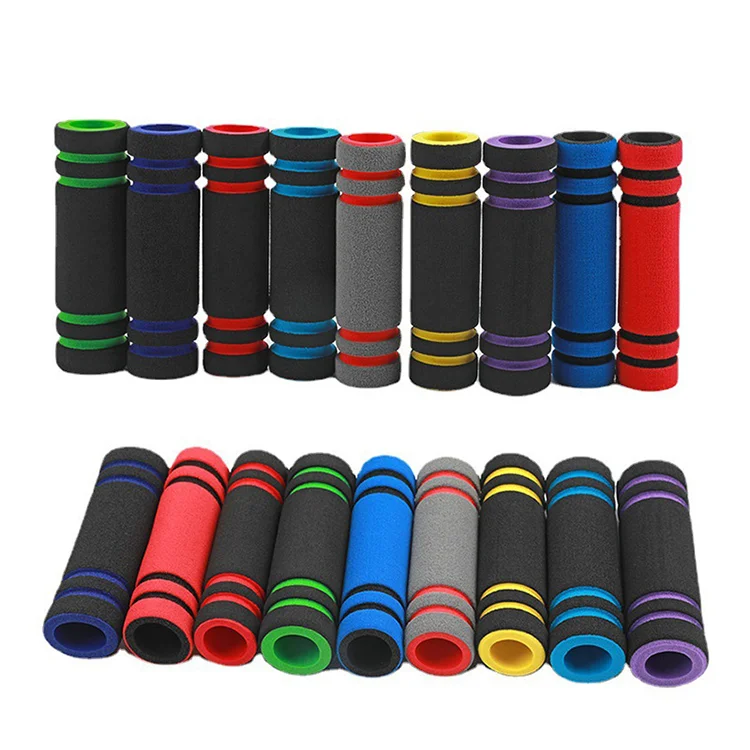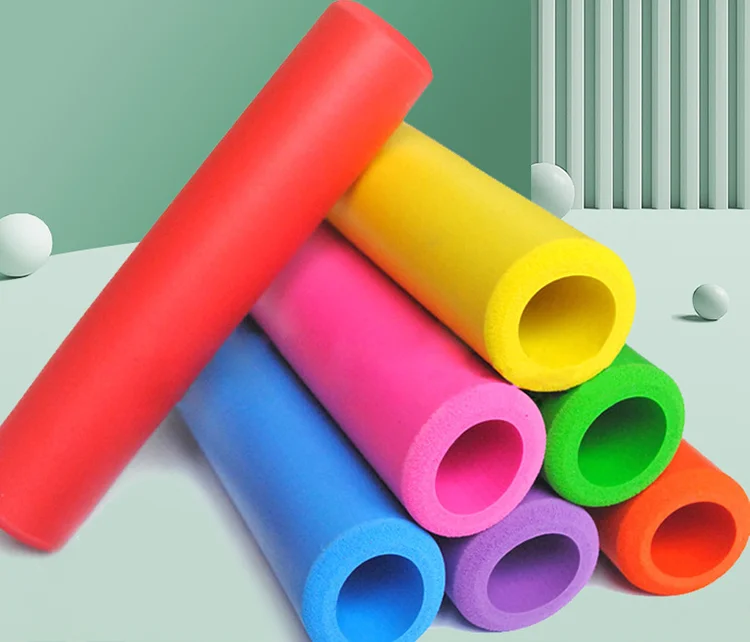Introduction
Have you ever wondered why some handle grips feel soft and cushiony, while others are firm and grippy—even under sweaty hands? The answer often comes down to the type of foam used. Among the most common materials in the market today are EVA foam and NBR foam, each with its own strengths, feel, and application range.
EVA (ethylene-vinyl acetate) is known for its lightweight, flexible, and smooth feel—popular in consumer-friendly products like jump ropes and children’s toys. On the other hand, NBR (nitrile butadiene rubber) foam is more rugged, textured, and oil-resistant, making it ideal for industrial tools and gym equipment.
As someone who works with rubber and foam materials daily at Kinsoe, I know how critical it is to choose the right grip material—whether you’re designing a fitness product, a power tool, or a kid’s toy. The wrong foam could lead to user discomfort, quicker wear and tear, or even safety issues.
In this article, I’ll break down the key differences between EVA and NBR foam, compare their technical properties, show where each is commonly used, and answer the most frequently asked questions from real-world buyers and product designers.

1. What Are EVA and NBR Foams?
Understanding the fundamental characteristics of EVA and NBR foams is the first step in selecting the right material for your handle grip application. Both materials are closed-cell foams, meaning they resist water absorption and provide a soft but firm cushioning—but their chemical makeup and physical behavior are quite different.
EVA Foam
EVA (Ethylene-Vinyl Acetate) is a thermoplastic elastomer that offers a unique combination of flexibility, softness, and resilience. As a closed-cell material, EVA traps air inside its structure, making it exceptionally lightweight and buoyant. It’s also known for good UV resistance and moderate durability.
EVA foam is widely used in applications where comfort and weight are key. I’ve seen it used in jump rope handles, children’s toys, yoga equipment, folding chairs, and lightweight packaging grips. It’s easy to cut, shape, and color, which makes it appealing for consumer goods and visually-driven designs.
“EVA feels soft in the hand, and it’s ideal when grip fatigue or prolonged use is a concern.”
However, EVA doesn’t hold up as well under oil, fuel, or repeated abrasive friction. It can also become slippery when wet.
NBR Foam
NBR (Nitrile Butadiene Rubber) foam is a synthetic rubber also formed in a closed-cell structure. It’s denser, firmer, and more oil-resistant than EVA. NBR’s rubber content gives it excellent chemical resistance, particularly to petroleum-based products, and superior performance in high-friction or high-contact environments.
In my experience, NBR foam is the go-to for more demanding use cases like power tool handles, bar grips in gyms, industrial control bars, and construction equipment. Its surface is usually textured, enhancing slip resistance even in sweaty or oily conditions.
“If grip security, durability, and chemical resistance are your top priorities, NBR stands out.”
Compared to EVA, NBR may feel less cushioned but more stable and long-lasting. It’s heavier and less elastic, but its toughness is often worth the tradeoff.
2. Comparative Properties of EVA and NBR for Handle Grips
To help you quickly assess which material better suits your grip application, I’ve put together a side-by-side comparison of EVA and NBR foam across key performance metrics. These are based on both lab testing and real-world product feedback we’ve encountered at Kinsoe.
| Property | EVA Foam | NBR Foam |
|---|---|---|
| Weight | Lightweight | Heavier |
| Flexibility | Softer, more pliable | Firmer, denser |
| Grip Comfort | Smooth, comfortable | Textured, slightly more grippy |
| Slip Resistance | Can get slippery when wet | Better anti-slip performance |
| Temperature Resistance | Moderate (–30°C to 70°C) | Good (–40°C to 100°C) |
| Chemical Resistance | Good with moisture/UV | Excellent with oils, fuels, solvents |
| Durability | Moderate—good for casual use | Excellent for high-friction applications |
| Common Uses | Sports gear, lightweight grips | Industrial, fitness, and machine handles |
Let’s break down a few of the most important traits:
- Weight & Comfort: EVA wins if weight-saving is a priority. In products like hiking gear or portable toys, this can make a big difference.
- Grip Feel & Friction: NBR’s firmer texture may feel more secure, especially when tools are used with gloves or in wet environments.
- Environmental Resistance: If you’re designing for outdoor or oily environments, NBR’s resistance to solvents and temperature swings offers a clear advantage.
- Durability: From gym barbells to factory control handles, NBR tends to last longer under daily stress and impact.
“There’s no universal winner—only the right fit for your product’s needs.”
This comparison table is a great tool when presenting material options to a procurement team or product manager. Each attribute aligns with a specific user experience or environmental challenge, so weigh these factors carefully.
3. Application Examples
When selecting a foam material for handle grips, context matters. The environment, user behavior, and product category all influence which material will perform best. Based on years of working with brands across fitness, industrial, and consumer product sectors, I’ve compiled some typical use cases that highlight the strengths of each material.

EVA Foam
EVA Foam Handle Grips
EVA foam is most commonly used in applications where comfort, aesthetics, and lightweight construction are prioritized. You’ll often find it in:
- Jump Ropes – Soft grip, ideal for long training sessions.
- Children’s Toys – Lightweight and easy to color, safe for bare hands.
- Folding Chairs – Adds comfort without extra weight.
- Fishing Rods – Provides a cushioned hold without increasing the load.
- Packaging Tube Sleeves – Protects hands during handling or transport of product tubes.
“In recreational gear and lightweight hand tools, EVA offers the best balance between cost, softness, and comfort.”

NBR Foam Handle Grips
NBR Foam Handle Grips
NBR foam shines in rugged or performance-critical applications where oil resistance, durability, and anti-slip features matter more than softness. Common uses include:
- Gym Equipment – Barbell grips, rowing machine handles, weight racks.
- Power Tools – Drill handles, grinder grips, saw handles where vibration dampening is critical.
- Industrial Bars – Found in control levers or machine handles exposed to grease or solvents.
- Wheelbarrow Handles – Withstands outdoor use, moisture, and heavy pushing.
- Construction Equipment – Offers secure grip even in oily or dusty environments.
“NBR is the top pick where reliability under pressure, friction, and chemical exposure is a must.”
By understanding how each material performs in these contexts, you can reverse-engineer your material decision based on real-world application needs—not just lab data or feel.
4. How to Choose Between EVA and NBR for Your Grip Product
When it comes to selecting the ideal foam material for handle grips, the decision hinges on your specific priorities—whether that’s user comfort, environmental resistance, durability, or product cost. Here’s how I typically help clients narrow down the best choice:
- If you prioritize lightweight comfort, especially for handheld products used over long durations or carried often, EVA is a great option. It’s softer to the touch, easy to shape, and makes the product feel more ergonomic without adding bulk.
- If your product must withstand rough handling, chemicals, or heavy-duty use, NBR foam is the superior choice. Its firmness, anti-slip texture, and resistance to oil and fuel make it perfect for industrial and professional-grade tools.
- Think about the usage environment. Will the grip be exposed to moisture, sweat, or oil? Will it be used outdoors under sunlight? In these conditions, NBR handles better over time, while EVA might lose its grip or degrade faster.
- Match the material to the expected frequency of use. For casual or occasional use, EVA can be more cost-effective. For frequent or heavy-duty use, NBR provides a better long-term return on investment despite the higher upfront cost.
- Budget and product positioning also matter. EVA is more economical and may suit entry-level or mass-market products. NBR, being more performance-oriented, often adds perceived value to mid-to-high-end designs.
“The right choice isn’t just about material—it’s about matching user expectations with engineering needs.”
In practice, I always advise sampling both materials when possible. Testing how they feel, perform, and age under real conditions can reveal subtleties that specs alone can’t capture.
NBR Foam
5. Q&A
After working with hundreds of grip-related projects, I’ve gathered some of the most frequently asked questions from product designers, sourcing managers, and end users. Here are the most common concerns—and my honest answers based on real experience.
Q1: Which material is more durable?
NBR foam generally outperforms EVA when it comes to long-term durability. It holds up better under heavy loads, repetitive friction, and exposure to oils or chemicals. EVA may compress or crack faster, especially in demanding environments.
Q2: Which one is better in sweaty or wet hands?
NBR is the clear winner here. Its textured surface and rubber composition provide superior grip, even when wet. EVA can become slick and less secure under similar conditions.
Q3: Which feels more comfortable?
EVA usually feels softer and more forgiving on bare hands, especially during extended use. If you’re making something for prolonged direct contact—like yoga accessories or hand tools for kids—EVA offers better comfort.
Q4: Which is lighter for portable equipment?
EVA is significantly lighter, making it ideal for products where total weight is a key consideration—like travel-friendly gear or lightweight sporting goods.
Q5: Do they smell or off-gas?
Both materials may have a slight odor when freshly manufactured. NBR, due to its rubber base, can retain more smell, especially if stored in sealed packaging. EVA tends to air out faster.
Q6: Are either recyclable or eco-friendly?
Unfortunately, neither material is biodegradable or widely recyclable. EVA is a thermoplastic, so it’s slightly more reusable in custom recycling streams. But for green design, both present challenges and may need to be replaced with newer sustainable foams if that’s a critical requirement.
Q7: Are they easy to clean?
NBR is easier to clean and more stain-resistant, especially when exposed to sweat, oil, or dirt. EVA, while water-resistant, can sometimes absorb residue or discolor over time if not maintained.
Q8: Is NBR worth the extra cost?
If your application demands high grip performance, exposure resistance, or heavy-duty use, then yes—NBR is worth the investment. For low-impact or casual-use products, EVA is often sufficient and more budget-friendly.
“Sometimes, paying more for material performance is what separates a product that lasts a season from one that lasts years.”
Conclusion
Both EVA and NBR foams offer distinct advantages when it comes to handle grip applications—but the best choice depends entirely on what your product demands.
If you’re designing for lightweight use, comfort, and affordability, EVA foam is your best bet. Its soft touch and low density make it ideal for consumer products, travel gear, and everyday tools that don’t face extreme stress.
But if you’re building for tough environments, heavy use, or exposure to oil and moisture, NBR foam stands out with its durability, superior grip, and chemical resistance. It’s the preferred choice for industrial tools, gym equipment, and outdoor applications.
“Choosing the right foam isn’t just about specs—it’s about ensuring lasting comfort, safety, and customer satisfaction.”
At Kinsoe, we understand the subtle but critical differences between materials like EVA and NBR because we work with them every day. Our team helps businesses like yours select the ideal foam type, match it to extrusion or molding profiles, and prototype custom grip solutions tailored to specific usage needs.
Need custom grip solutions in EVA or NBR? Contact us to discuss material selection, get expert recommendations, or request a sample kit tailored to your application. Let’s make your next product a better one—right from the grip.


